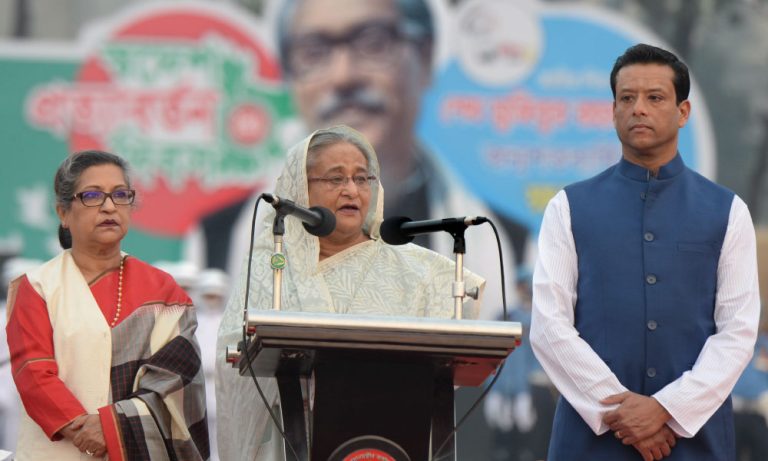The tragedy of Bangladeshi national liberation under the Hasina regime
After the murder of Sheikh Mujibur Rahman in 1975, military dictators ruled Bangladesh for two and a half decades and a parliamentary system resumed in 1990. One of the two of Sheikh Mujib’s living children, Sheikh Hasina reorganized Awami League and contested the 1991 general elections but lost. Awami League won the elections and came into power in 1996, but not with a strong enough majority to resume the political project of Sheikh Mujib. That overwhelming majority came about in the 2008 election when Awami League won two-thirds majority in the national parliament and was rendered with the authority to amend the constitution and institute any law they wanted to without caring about the opposition.
However, this Awami League was limited by its commitment to the neoliberal national and international bourgeois that helped it ascend to power. As such, they had to transform the economic development legacy of Sheikh Mujib that targeted the intermediate class and shift it towards a rhetoric that could benefit the neoliberal bourgeoisie.
Hasina’s Awami League used Sheikh Mujib’s legacy to justify populist practices that strengthened its hold on power. It continued to oppress the indigenous people using the Bengali nationalist claims originated by Mujib. It used Mujib’s legacy to maintain a constitution that included both the provisions of a state religion and secularism as one of the four main principles. These steps were taken to please the Islamist civil society and the progressive civil society members so that they would not mobilize as the representatives of the peasantry and the working class.
She has given land grants and political advantage to the Islamist civil society leaders on one hand (by removing the statue of a woman from the Supreme Court premises as per Hefazat-e-Islam’s demand, omitting writings of “objectionable” authors as per Hefazat’s definition etc) and has given economic and social advantage to the secularist civil society leaders by giving them civilian awards, leadership roles in the government and funding their organizations on the other.
Such a position has been supported by the national bourgeoisie which has crystallized following the post-1980 neoliberal reforms and taken over the position of the base support group of the Awami League from the intermediate class. The neoliberal national bourgeoisie’s livelihoods now depend on foreign direct investment contingent upon the stability of the country’s political situation regardless of the underlying instability of the citizen’s lives. This neoliberal turn has given rise to the need for a popular leader whose dual role is to stabilize the regime and to perpetuate the domination of the bourgeoisie. Sheikh Hasina fits perfectly into that role. The bourgeois dictatorship of Bangladesh drew its strength from her existence.
Yet, Sheikh Hasina, being the daughter of the founding father and the leader of the Awami league, attempts to pacify the people by churning out the history of independence and recalling the united front of the liberation struggle. Every time she addresses the people, she recalls Sheikh Mujib’s heroic life, the battles waged and the victories won in the people’s name, thus conveying to the masses they should continue to place their trust in him, his daughter and his party.
In every political poster of Awami League, a photo of Sheikh Mujib can be seen, followed by the photo of her daughter Sheikh Hasina and now sometimes her son Sajeeb Wazed. During the struggle for liberation, Sheikh Mujib riled the people up and promised them a radical, heroic march forward in the name of Golden Bengal. But today, Sheikh Hasina repeatedly endeavors to lull them to sleep and three or four times a year asks them to remember the colonial period and to take stock of the immense distance they have covered.
While Sheikh Hasina lulls the people into sleep, his Harvard-trained son performs the inception of a new dream. A dream of Digital Bangladesh. A dream that is borrowed from the global capital, one that contends that the life of a peasant is an undesirable and backward one and one must give their life up and learn to mirror the life of the urban elite. The dream that dictates that the villagers must get out of the villages and integrate with the global capital in order to be developed.
More attention is given towards building technology centers in the villages than is given towards flood prevention even after villagers continue to demand infrastructure. Treaties are made with foreign countries requiring cheap labor to export the landless out of the country. The party boasts of creating 2.5 million jobs in foreign countries where they must work with little or no rights. It boasts of creating 6.9 million jobs in the domestic sector where the workers are often killed due to the callousness of the capital and the state (e.g no fire escapes in Tajrin Garments and unsafe building practices in Rana Plaza), are not paid their wages regularly and are violated in many other ways. When the workers organize a strike against such practices, the state deploys its police to forcibly end them.
While the 2014 manifesto dwells much on this neoliberal model of development, it speaks only tangentially about the practices to sustain and develop the rural economy. It only touches tangentially on dire issues like river erosion, climate change and flooding that directly affect the life and livelihoods of millions of rural Bangladeshis whereas it lays out detail plans of a digital Bangladesh where information technology is used everywhere and by everyone and is massively subsidized by the central government. No longer do they speak of a Golden Bengal, they speak of a Digital Bangladesh where we can earn by working for multinational corporations.
The underlying ethos of such a development model is: the livelihoods of villagers are not worth saving. The land of the peasantry is not worth protecting. The landless are not worth the redistribution of Khas land. The only means of salvation for the poor is to work for the rich. And to make that palatable, Golden Bengal has been replaced with Digital Bangladesh.
The displacement of the peasantry from the discourse of national liberation results in, what Fanon called “a deprecatory judgment of his original way of life”. This logical inferiorisation of the peasantry through and through gives the state a recourse to dispossess the peasantry to build special economic zones for the interest of the national bourgeoisie and attempts to pacify the people, meanwhile, with the hopes of jobs in the modern industry, denying the peasantry a way towards modernity in its own terms.
Such a model creates two parallel subcultures within the country which are juxtaposed and not harmonized. In Cesaire’s words, a Bengali capitalist society has developed in the image of the global capital that aspires to be a competitor in the global capital. And then there is the peasantry, the working class and the urban poor who are constantly encouraged to sacrifice their subculture and integrate with the mainstream capitalist culture. However, this integration is often unsuccessful. The result of this insufficient integration is the development of a veritable cultural mosaic. The harmonious synthesis of the old indigenous culture has been dissolved and replaced by a hodgepodge of features of different origin, overlapping one another without harmonizing.
National liberation in Bangladesh has been through many trials and tribulations since the independence of the state. In this article, I have focused mostly upon the transition of the idea under the rule of Awami League, the party that lead the liberation struggle of the country. I have explored how the rhetoric of liberation transformed from the agrarian paradigm of Shonar Bangla (Golden Bengal) to the neoliberal paradigm of digital Bangladesh with the continuous vanishing of the concerns for the peasantry and the working class in the process. I have argued that the national party (Awami League) has largely based its clientele in the intermediate class (in the post-independence years) and the neoliberal national bourgeoisie class (in the post-2008 years). Lastly, I have discussed the cultural stratification that has taken place due to such neglect of the peasantry and the working class. I observe that there has been a parallel development of two subcultures in Bangladesh that are juxtaposed and not harmonized. The first subculture is that of the neoliberal bourgeoisie and the second one is that of the peasantry and the working class. The current structure of the state has effectively declared the subculture of the peasantry and the working class as undesirable and has been encouraging them to discard their traditional culture and integrate into the dominant paradigm of the neoliberal subculture where they will be placed at the bottom as the servants of the national bourgeoisie.
This article has been taken from a term paper written as a course requirement for the Pan Africanism and Post Colonialism course with Professors Gayatri Chakravorty Spivak and Mamadou Diouf at Columbia University in 2017.


